Indian Wedding Glossary of Traditions, Rituals and Terms
Here’s a helpful Indian wedding glossary to help understand key Indian wedding traditions, rituals, and terms, especially for those planning multicultural or fusion weddings. Understanding these customs will help create a truly memorable day.
Aarti
Aarti is a deeply spiritual Hindu ritual in which a deity is worshiped by lighting a lamp or diya (small oil lamp) and offering items like flowers and incense. The word “aarti” is derived from the Sanskrit word “arati,” meaning “to remove darkness.” This ritual often involves the singing of devotional songs, the ringing of bells, and the movement of a diya in a circular motion before the deity’s image. Aarti is performed both in temples and homes as a daily act of worship or during special ceremonies to show devotion and receive blessings.
Ashirvaad
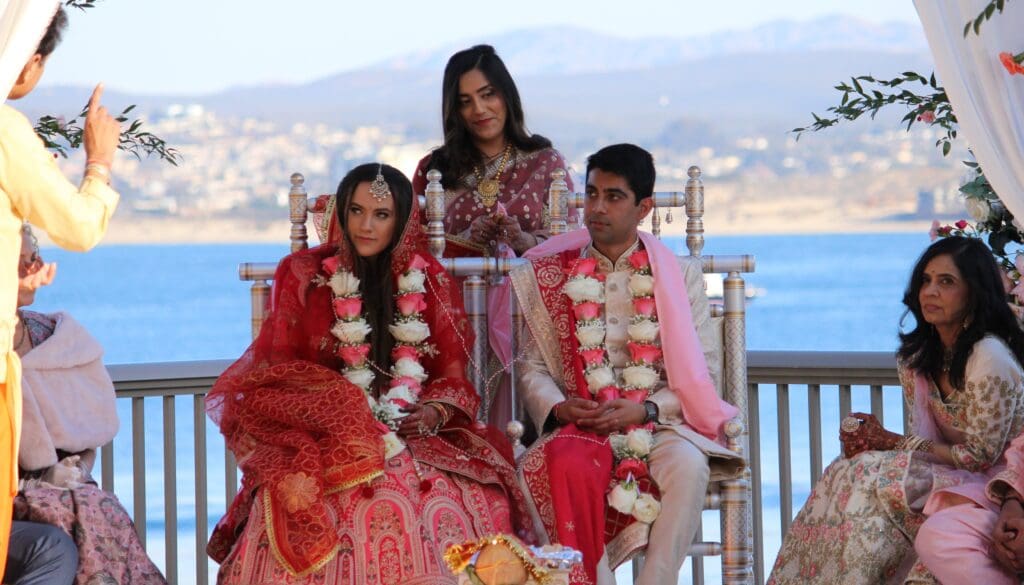
In Hindu culture, ashirvaad refers to blessings, often given by elders, especially parents and grandparents, to younger generations. It is a way of expressing love, guidance, and protection, with a belief that the blessings bring good fortune and happiness. During weddings, elders from both families bless the newlyweds with kind words and advice, wishing them a joyful and prosperous married life. This act of giving ashirvaad is a meaningful gesture that strengthens familial bonds.
Agni
Agni is the Hindu god of fire and is revered as a powerful mediator between humans and the divine. During many Hindu rituals, offerings like ghee (clarified butter) or rice are made to Agni by placing them in a sacred fire. In weddings, Agni plays a critical role by acting as a witness to the couple’s vows, with the fire representing purity and the divine presence. Agni is also believed to transport offerings to the gods, making fire rituals central to Hindu worship.
Akhand Saubhagyavati
This is a special pre-wedding ritual where Hindu scriptures are continuously recited for up to 48 hours, asking for blessings on the couple. This sacred tradition, which is often performed a few days before the wedding, is intended to bring prosperity, happiness, and long-lasting marital bliss. Family members and friends take part in this ceremony, which is seen as a way to invoke the blessings of Lord Ganesha, the god of beginnings and remover of obstacles.
Antarpaat
The Antarpaat ceremony is a traditional part of Hindu weddings that symbolizes the merging of two families. It happens after the bride and groom have taken their seven vows (saat phere). The couple stands on either side of a cloth veil, which is lifted to signify the moment when their lives come together as one. Families offer flowers, sweets, and well wishes, and in some communities, the couple exchanges garlands as a symbol of their union.
Baraat
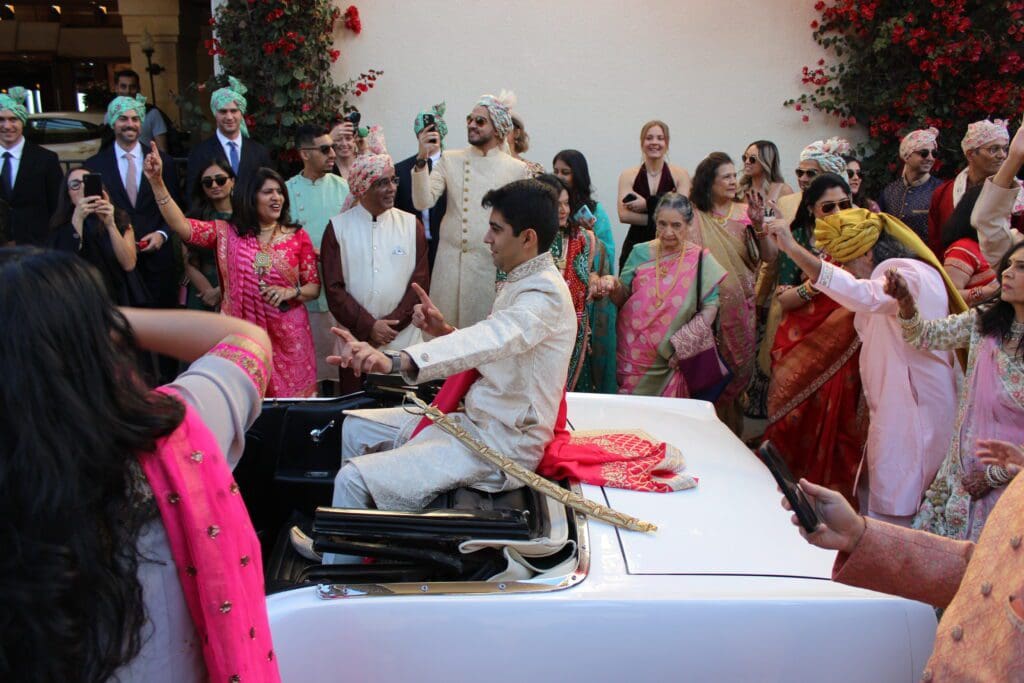
The baraat is the lively and festive procession of the groom’s family and friends to the wedding venue. Often, the groom arrives on a horse or in a beautifully decorated automobile, surrounded by loved ones dancing and celebrating along the way. The baraat is filled with music, traditionally played by dhol drummers, and is one of the most anticipated and colorful parts of the wedding day. In the west the music is typically provided by a DJ with a portable Baraat sound system accompanied by a dhol player. Once the baraat reaches the venue, the groom is formally welcomed by the bride’s family, marking the beginning of the wedding festivities.
Bindi
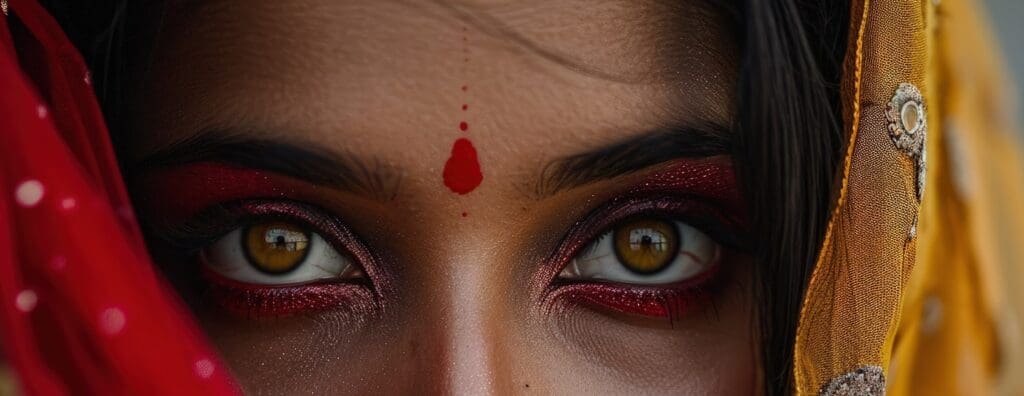
A bindi is a small decorative dot worn on the forehead by Hindu women, symbolizing marital status, good fortune, and inner wisdom. Traditionally, bindis are made from colored powder or jewels and placed between the eyebrows, an area believed to be the seat of spiritual insight. Although it originated as a cultural and religious mark, today bindis are also worn as a fashion accessory by women of different backgrounds.
Dhol Player
A dhol player is a skilled musician who plays the dhol, a traditional double-sided drum known for its deep, rhythmic sound. This instrument is especially popular during wedding processions and celebrations like the baraat, where its beats set the perfect mood for dancing and celebration. The dhol is also used in various South Asian musical styles, including bhangra, and remains a vital part of wedding entertainment.
Dholki
The dholki is a smaller, hand-played drum often used in traditional South Asian music. It is typically played at smaller, informal gatherings leading up to the wedding, such as the mehendi or sangeet ceremonies. The dholki creates a lively, upbeat rhythm, and its sound often encourages singing and dancing among guests, making it a favorite for intimate, festive pre-wedding events.
Doli
The doli refers to the traditional palanquin or sedan chair that carries the bride to her husband’s home after the wedding ceremony. This emotional and joyful procession marks the bride’s departure from her family and the start of her new life. Traditionally, the bride would be carried by her relatives, but in modern weddings, the doli is often replaced by decorated cars or other transportation, still maintaining the same symbolism of the bride’s transition.
Ganesh Pooja
The Ganesh Pooja is a Hindu ritual dedicated to Lord Ganesha, the deity known for being the remover of obstacles and the god of beginnings. This ceremony is often performed at the start of any new journey or venture, such as a wedding, to invoke blessings for success and to ensure that challenges are cleared away. The ritual involves offerings of flowers, sweets, and incense, while prayers are recited to ask for Ganesha’s guidance and support. In a wedding context, the Ganesh Pooja is typically one of the first ceremonies held, ensuring smooth and joyful proceedings for the couple’s big day.
Grahapravesh
Grahapravesh, also called Grihapravesh, is the ceremonial entry of a newlywed couple into their new home. This ritual is steeped in tradition, symbolizing the start of their married life. Held on an auspicious date, Grahapravesh includes welcoming the couple with offerings of rice, flowers, and other symbolic items to bless their new life together. The couple performs a puja (prayer ceremony) at the entrance of their new home, invoking divine blessings for prosperity and happiness in their shared life. This significant event is often celebrated with family and friends and is an important milestone in the couple’s journey together.
Haldi Ceremony
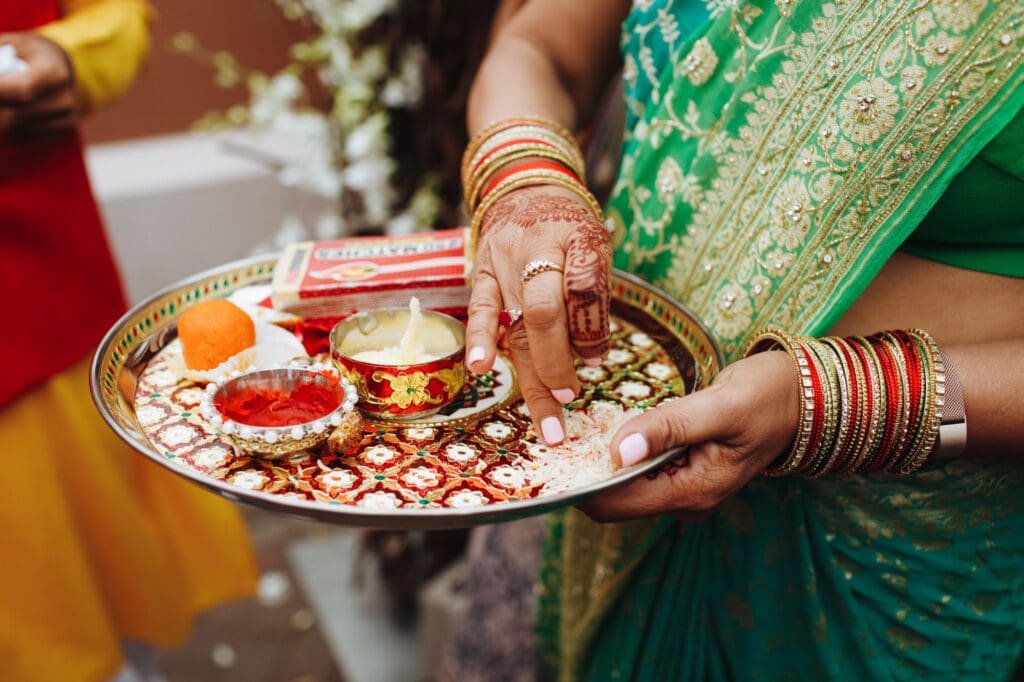
The Haldi ceremony is a joyful and vibrant pre-wedding tradition where a paste made from turmeric, sandalwood, and other ingredients is applied to the bride and groom. This mixture is believed to bring good luck, ward off evil spirits, and provide a natural glow to their skin before the big day. Held a few days before the wedding, the Haldi ceremony is usually filled with laughter and fun as family members take turns applying the turmeric mixture to the couple. It’s a significant moment in the lead-up to the wedding and is cherished for the blessings of prosperity and happiness it brings.
Hasta Melap
Hasta Melap, meaning “joining of hands,” is a pivotal ritual during a Hindu wedding where the bride and groom’s hands are ceremonially bound together. This act symbolizes their union and lifelong commitment to one another. A sacred thread or cloth is used to tie their hands while the priest chants mantras that bless the couple. After this, the couple circles a sacred fire, taking vows to support and cherish each other. The Hasta Melap is a moment of deep emotional significance, marking the official union of the couple in the presence of their families and the divine.
Havan Kund
The Havan Kund is a sacred fire pit central to many Hindu rituals, particularly the havan or yajna (fire sacrifices). During wedding ceremonies, offerings like ghee, grains, and wood are placed into the fire while mantras are recited to invoke blessings from the gods. The fire is believed to carry these offerings to the divine, purifying the surroundings and ensuring positive energy for the couple’s future. The Havan Kund serves as the heart of the ceremony, symbolizing divine presence and spiritual purity.
Jago Ceremony
The Jago is an upbeat pre-wedding ritual held to awaken the bride and groom for the wedding festivities ahead. Typically hosted the night before the wedding at the bride’s home, this lively celebration involves singing, dancing, and joyous revelry among family and friends. In some communities, religious rituals like lighting lamps and reciting prayers are also incorporated. The Jago ceremony is a time to energize everyone involved and marks the beginning of the wedding celebrations in high spirits.
Jaimala
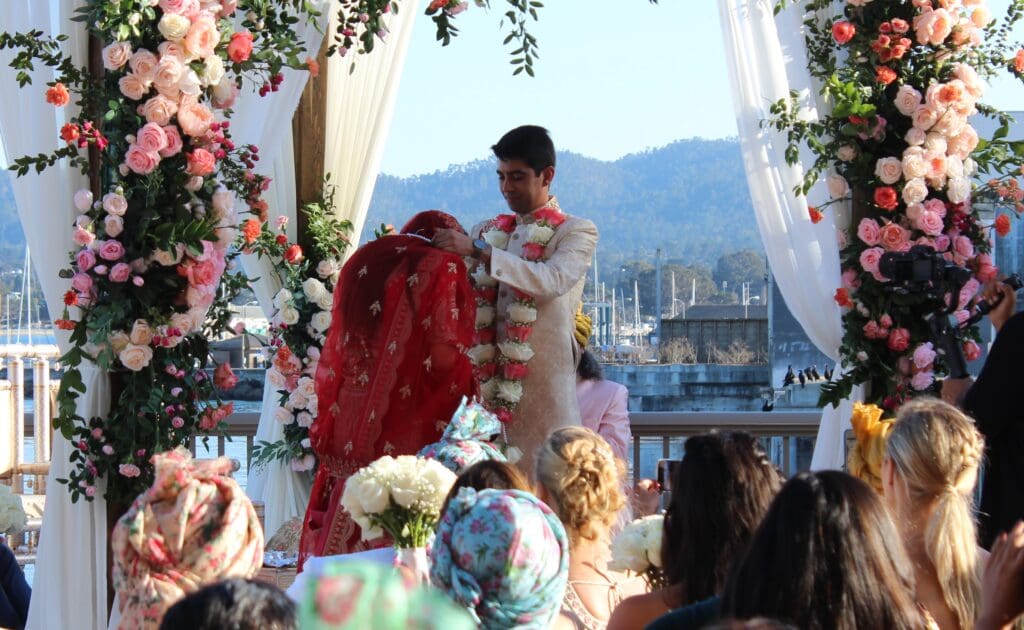
The Jaimala is a touching moment during a Hindu wedding where the bride and groom exchange floral garlands. This act symbolizes their mutual acceptance of each other as partners and is one of the most anticipated parts of the wedding. The garlands, usually made from fragrant flowers like marigolds, are exchanged in front of gathered guests, who shower the couple with petals as a gesture of love and blessings. The Jaimala is not only a beautiful visual moment but also a symbolic exchange of respect and commitment between the couple.
Kansar Bhaksha
Kansar Bhaksha is a sweet tradition in which the bride and groom feed each other a dish made of wheat, ghee, and sugar, symbolizing their mutual care and commitment. This ritual takes place during the wedding ceremony as an offering of gratitude to the gods for their blessings. By feeding each other, the couple demonstrates their promise to support and nourish each other throughout their married life. This sweet moment is also a gesture of prosperity and happiness for their new journey together.
Kanyadaan
Kanyadaan is one of the most heartfelt and meaningful rituals in a Hindu wedding, where the bride’s father gives his daughter’s hand to the groom, entrusting him with her care and well-being. The father offers the bride’s hand as a symbol of selfless love and the transfer of responsibility from father to husband. Accompanied by sacred prayers and witnessed by close family, the groom accepts this responsibility, promising to cherish and protect his bride. Kanyadaan is considered a deeply emotional and sacred moment, marking the union of two families and the beginning of a new chapter in the couple’s lives.
Mandap
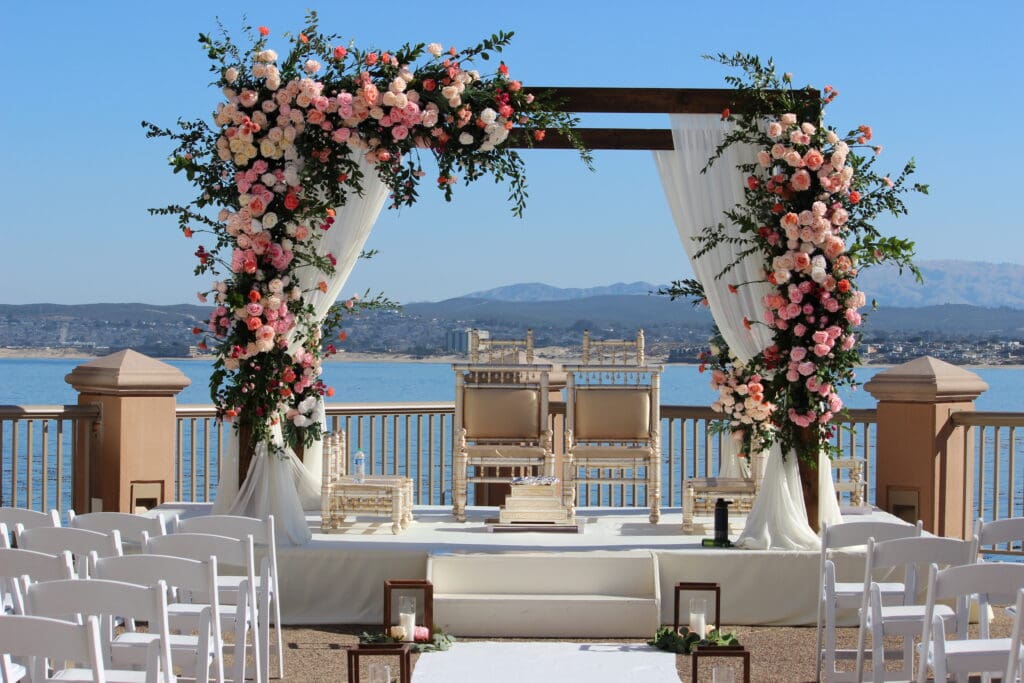
The mandap is the beautifully adorned ceremonial platform where the core of a Hindu wedding takes place. It is typically an elegant structure made from wood or draped fabric, serving as the sacred space where the bride and groom exchange vows and participate in other key wedding rituals, such as the lighting of the holy fire (havan) and the exchange of garlands (jaimala). With flowers, lights, and intricate decorations, the mandap becomes a symbolic space that represents the union of not just the couple, but their families and communities as well.
Mangalsutra
A mangalsutra is a symbolic necklace worn by married Hindu women, marking their marital status. Traditionally made of black or yellow beads with a central pendant, it signifies the union of the bride and groom. The groom places the mangalsutra around the bride’s neck during the wedding ceremony, representing the bond of marriage and their commitment to each other. Beyond being a piece of jewelry, the mangalsutra is believed to bring good fortune and protection to the marriage. Its design can vary depending on regional customs, but it remains a powerful symbol of the sacred marital bond.
Mehendi Ceremony
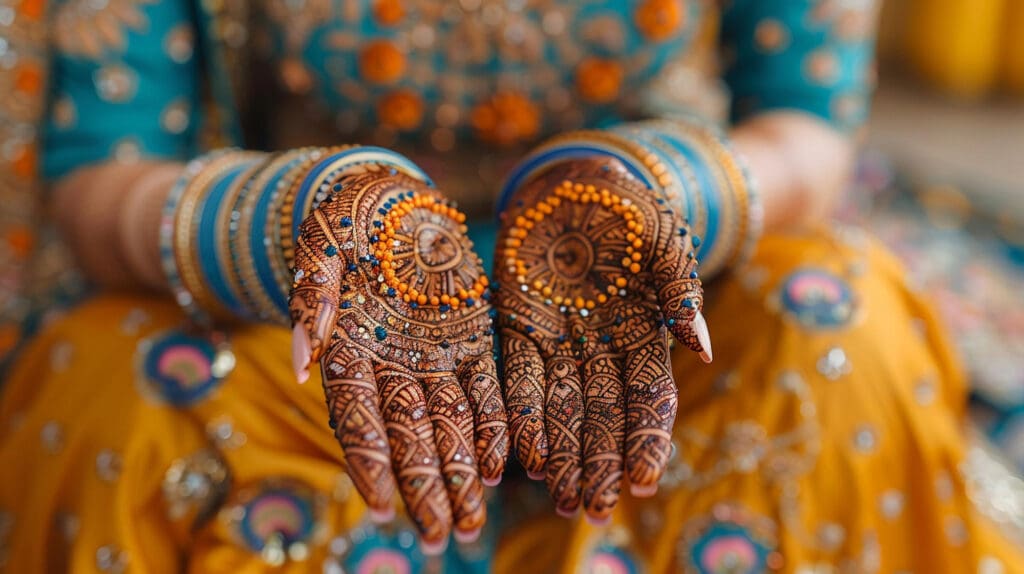
The Mehendi ceremony is a joyful pre-wedding tradition where intricate henna designs are applied to the bride’s hands and feet. Typically held a few days before the wedding, this event celebrates beauty, luck, and good fortune. It’s a lively gathering filled with music, dance, and laughter, and is often attended by close female relatives and friends. The stunning henna patterns not only beautify the bride but are also believed to bring positive energy and blessings for the new chapter of her life.
Milni
Milni is a welcoming ceremony where the families of the bride and groom formally meet before the wedding. It’s a special moment, usually just before the main wedding ceremony, where garlands and gifts are exchanged between the two families, symbolizing mutual respect and acceptance. Accompanied by traditional music and songs, the Milni is an important ritual that fosters connection and joy between the families, setting a harmonious tone for the upcoming celebrations.
Nikah
Nikah is the formal Islamic wedding ceremony, signifying the union of the bride and groom. Performed in the presence of witnesses and overseen by an imam or religious scholar, the couple declares their intent to marry and signs a marriage contract. This document outlines the rights and responsibilities of both parties. Nikah is a religious commitment, often followed by festive celebrations that include music, food, and dancing, though the ceremony itself is solemn and sacred. The Nikah marks the couple’s spiritual and legal union in accordance with Islamic law.
Paath
Paath is the recitation of sacred Hindu scriptures or prayers. It is a devotional practice performed individually or in groups, often under the guidance of a priest, to invoke blessings and purify the mind and soul. Whether it’s reading from texts like the Vedas or Bhagavad Gita, Paath is a way of connecting with the divine and seeking spiritual growth. In weddings, Paath may be performed to bless the couple with health, happiness, and prosperity as they begin their journey together.
Panchang
The Panchang is a Hindu almanac used to determine the most auspicious dates and times for important events like weddings. Derived from five elements—Tithi (lunar day), Nakshatra (lunar mansion), Yoga (sun and moon alignment), Karana (half of a Tithi), and Var (day of the week)—it helps guide rituals and ceremonies according to celestial movements. Astrologers or priests often consult the Panchang to ensure that significant life events take place under the most favorable conditions, bringing good fortune to the couple and their families.
Pithi Ceremony
The Pithi ceremony is a fun and auspicious pre-wedding tradition where a paste made of turmeric, sandalwood, and other natural ingredients is applied to the bride and groom’s skin. The ritual is believed to bring good luck and enhance the natural glow of the couple before their big day. Family and friends take turns applying the mixture, often turning it into a lively and joyous event. The Pithi ceremony is a way for loved ones to show their support while preparing the couple for a prosperous and happy marriage.
Roka Ceremony
The Roka ceremony is one of the first pre-wedding traditions in a Hindu wedding, marking the formal engagement of the couple. Held in an intimate setting, often at the home of the bride or groom, it is a joyous event where both families come together to bless the union. Gifts are exchanged, sweets are shared, and the families formally announce the upcoming marriage. The Roka signifies the beginning of the wedding preparations and the official coming together of two families.
Saat Phere

The Saat Phere, or Seven Sacred Steps, is a cornerstone of Hindu wedding rituals. During this ceremony, the bride and groom take seven vows, each representing a commitment to each other and their life together. As they circle the sacred fire, they promise to support one another, share in each other’s joys and challenges, and remain faithful and loving partners. These vows form the foundation of their marriage and are witnessed by family, friends, and the divine, making the Saat Phere one of the most significant moments in the wedding.
Sagaai
Sagaai, or engagement ceremony, is a pre-wedding ritual that marks the formal commitment of the couple to marry. Often a small gathering with close family and friends, the Sagaai includes the exchange of rings between the bride and groom, symbolizing their promise to one another. The ceremony is followed by a celebratory meal and marks the beginning of the wedding preparations, setting the tone for the upcoming festivities.
Sangeet

The Sangeet is a musical pre-wedding celebration, typically held the night before the wedding. It’s a festive event filled with singing, dancing, and performances by both families. Traditionally hosted by the bride’s side, the Sangeet allows both families to bond over joyful celebrations before the wedding. Often an extravagant affair, it is a time for everyone to let loose and enjoy themselves, building excitement and camaraderie before the main ceremony.
Saptapadi
Saptapadi, meaning “seven steps,” is a sacred ritual in which the bride and groom walk together around a fire, taking seven vows to commit to each other for life. Each step represents a promise—such as love, loyalty, and support—that will guide them throughout their marriage. The Saptapadi is a key part of the Hindu wedding, symbolizing the couple’s journey together, and is seen as the formal beginning of their union as a married couple.
Sindoor
Sindoor is a traditional red or orange vermilion powder applied by Hindu married women along the parting of their hair. This practice signifies a woman’s married status and her devotion to her husband. During the wedding ceremony, the groom applies sindoor to the bride, symbolizing her transition into married life. It is also associated with the goddess Parvati, the ideal wife in Hindu mythology, representing a woman’s commitment to her spouse and her role in their shared life.
Varmala
The Varmala ceremony involves the exchange of floral garlands between the bride and groom, symbolizing their acceptance of each other as life partners. This important ritual takes place during the wedding and is often accompanied by the joyous cheers of family and friends. The Varmala marks the start of the wedding celebrations, setting the stage for the couple’s union in a festive and symbolic manner.
Vidaai
Vidaai is an emotional moment at the end of the wedding ceremony, where the bride bids farewell to her family and leaves for her new home with her husband. This ritual marks the bride’s transition from her parental home to her new life, often accompanied by tears and blessings from her loved ones. While bittersweet, the Vidaai is a pivotal moment in the wedding, symbolizing the start of the bride’s new journey with her husband and in-laws.
This Indian wedding glossary helps you explore the beautiful and intricate rituals that make Indian weddings so special, whether you’re planning a traditional event or a fusion celebration.
By DJ Justin Warwick of DJ Enterprises Mobile Disc Jockey, aka DJ Warwick

Justin Warwick. The dynamic force behind DJ Enterprises Mobile Disc Jockey, has been a trailblazer in professional DJ entertainment since 1989. Serving the Central Coast Monterey Bay area and beyond. Justin specializes in creating unforgettable experiences for weddings, corporate events, New Years, anniversaries, birthdays, and a variety of social events. Known for his ability to bring joy, fun, excitement, and energy to every event. Justin’s expertise ensures a memorable experience for you and your guests. One of Justin’s standout contributions to the wedding world is the “Table Dash game,” a high–energy reception activity he created in the early–2000s.
With thousands of successful events under his belt, Justin Warwick is renowned for his exceptional DJ and MC skills. He has a unique ability to read the crowd and tailor the music to fit the atmosphere perfectly. Whether it’s an intimate gathering or a grand celebration. Justin’s extensive music knowledge and state-of-the-art equipment guarantee a seamless and enjoyable event.
For those planning an event in the Carmel / Pebble Beach / Monterey Bay area. The Monterey Wedding DJ Blog offers a wealth of tips and ideas. It’s the most-read wedding DJ blog in California. Providing insights into crafting the perfect playlist, venues, and staying updated on the latest trends in wedding and event planning.
“I’d love the opportunity to be your Wedding or Party DJ and provide Photo Booth services.” Reach out to me at dj.justinwarwick@gmail.com or visit (https://djwarwick.com) for more information. I look forward to hearing from you!
Explore the website for more details on services, pricing, and client testimonials to see why DJ Justin Warwick is the best choice for your next event. https://djwarwick.com
Please feel free to share!
